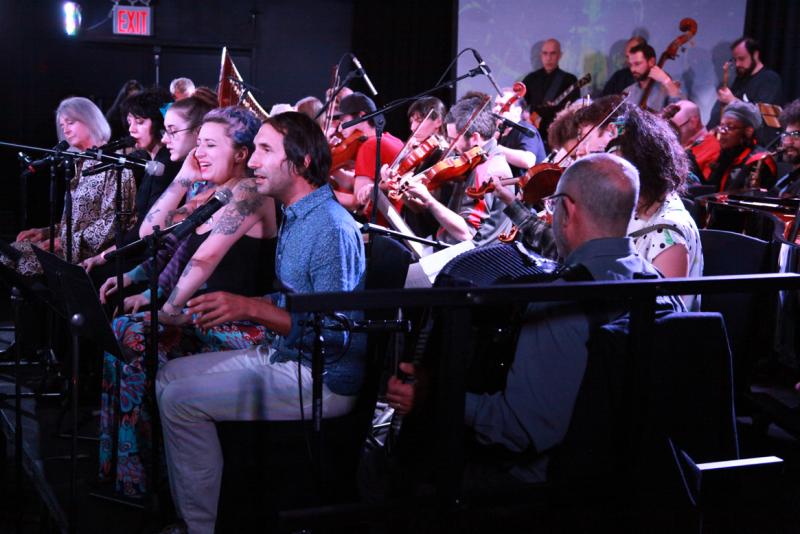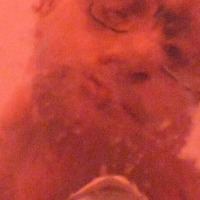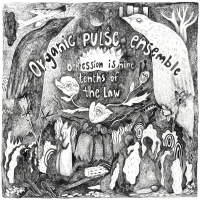Home » Jazz Articles » Live From New York » The Music Of Terry Riley, Miriam Makeba, Andy Warhol & Gil Evans
The Music Of Terry Riley, Miriam Makeba, Andy Warhol & Gil Evans

(le) Poisson Rouge
November 4, 2014
This rendition of Terry Riley's "In C" was presented by a grouping that virtually has no name. The Darmstadt Essential Repertoire team (long associated with Brooklyn's Issue Project Room) have been presenting an annual invocation of this pioneering minimalist classic by the almost octogenarian Californian composer. In recent years, the Poisson on Bleecker Street has been involved, and the venue's in-house ensemble formed the core of this massive stage invasion. The 1964 work is now celebrating its 50th anniversary, so a special resonance was spiriting around the sold-out house.
Simply put, the piece revolves around sequences and groupings of repeated matter, with the players deciding which of its 53 phrases they tackle, with (usually) one musician providing a metronomic pulse. There is no set duration, although most performances tend to last between an hour and 75 minutes. In most cases, the number is performed by a grouping with a classical construction, but sometimes a rock gang will grab it with their soiled mitts. In essence, this particular gathering combined a spread of strings, a horn section and a cluster of electric guitars, thereby gaining the optimum aspects of several spheres. Better-known names amongst the roster included Jessica Pavone (viola), Justin Kantor (cello and Poisson co-founder), David Grubbs, Elliott Sharp (guitars), Zach Layton (electric bass), Matana Roberts (alto saxophone), Joan La Barbara (vocals), Shelly Burgon (harp), and Miya Masaoka (koto). The spread also included pairs of accordionists and keyboardists, plus a percussionist, as well as four other singers.
Whether the onstage mix favoured certain resonances, or whether this was a deliberate strategy, it was the voices and the piano pulse that tended to separate themselves the most, levitating from the steady plain of massed string-meshing. At times, the horns became more markedly throaty, then the percussionist weighed in with a more emphatic pulse, a drive, even. The koto and accordions weren't able to assert their individual nature, but this is a piece which can't avoid creating a massed, one-voice feeling, the joy being in the progression, the tidal pull, the ascendance, the occasionally stilling pulse, the visible state of ecstasy attained by the communal interactions of the vocal crew. There were casualties too. There was a certain point where several punters seemed to be reminded of their timepieces, some of them curiously departing only around 15 minutes before the work's conclusion. They must have just hit the space of no return. Admittedly there might have been some natural lull around this point, but that's part of the pleasure, because it's assured that the piece will rise once more, and indeed it did, gathering further forces for the final circuit, before winding down towards its natural death. The repetition is not really anywhere near total repetition, and even if it was, we were surely seeking the numbed buzzing vibration that arrives with all the best minimalist music, where the air itself starts to wobble in sympathy with the sound.
Angélique Kidjo
Carnegie Hall
November 5, 2014
This was the climactic gig in Carnegie's extensive Ubuntu series of South African music and arts. It was probably one of its biggest productions, as many of the shows took place down in the smaller Zankel Hall. This one was in the main auditorium, and featured Angélique Kidjo, assisted by a trio of guest vocalists, their mission being to pay tribute to South Africa's most famed singer, Miriam Makeba. Furthermore, the evening attained sold-out status, which certainly helped with the general partying atmosphere. Ultimately, it may well have taken a sizable chunk of this two-hour extravaganza to fully arouse the crowd, but Kidjo and friends had the luxury of a leisurely climb.
Kidjo might have been sprouted in Benin, but the music of South Africa, and particularly of exile and activist Makeba, has been flowing through her inner system for decades. She actually studied with the so-called Mama Africa, and subsequently performed with her and her band. On this dedicated night, there were many songs to breeze through, but also quite a lot of available time, and the show maintained variety via strategic introductions of the guests, either for their own showcases, or sometimes a duet or two. There was also a trio of backing singers, all of whom shared extensive experience on the road with Makeba.
The guest singers were an assorted bunch, with the most inexplicable choice being the first to appear. Ezra Koenig's thin, warbly voice was ill-suited to the strength of the Xhosa-rooted Makeba's demands, and he seemed completely at sea with this repertoire. His band, Vampire Weekend, are dedicated to a dilute palette of Afro-pop, so this came as little surprise. Far more suited was the English alternative pop success Laura Mvula, who retained the distinctive personality of her phrasing, whilst still adapting to this strange new world. Although perhaps not so alien, as her early years were spent singing gospel in Birmingham, England.
The material ranged up and onwards from Makeba's initial success of 1960, "The Click Song," through virtually five decades of output, this particular tune handled by South African star Vusi Mahlesela. Even so, to the average non-specialist it was the closing "Pata Pata" and "Soweto Blues" that held the most universal resonance. Many of the songs were not so familiar to anyone who wasn't a hardcore Makeba fan, or an actual child of South Africa. For an artist so full of her own spunky personality, it was curious to witness Kidjo taking on the mantle of another, although it was her own anthem, "Afirika" which actually ignited the house, partly because of the immense drive of her delivery, and partly that this was offered during an extreme walkabout of Carnegie, even ascending to the first balcony. Most singers never get to climb those stairs! The audience stood up, clapped and sang along, vivified by Kidjo's charismatic cajoling. Unfortunately, this hard work was completely obviated by the following 20 minute band introduction, one of the most tedious ever endured by this scribe, made worse by the fact that there wasn't a song pay-off at its conclusion, just a sharp end to the evening, and a sudden lights-up evacuation.
Exposed: Songs For Unseen Warhol Films
Brooklyn Academy Of Music
November 8, 2014
Not that Andy Warhol penned the music for this short-silent-films-with-live-sounds performance, but his influence remains so all-pervasive that a sense of Svengali guidance swirled strongly around the grandiose vaultings of BAM's Howard Gilman Opera House. Back in the 1960s, a seedier environment would have sufficed. Guitarist Dean Wareham (best known as a member of Galaxie 500) took on the mantle of music curator for this three night screening of previously unseen obscurities (well, aside from earlier in the US tour of this Andy Warhol Museum exhumation/commission). Wareham's taste was impeccable, as he invited along guitarist Tom Verlaine (Television), keyboardist Martin Rev (Suicide) and singer-guitarist Eleanor Friedberger (The Fiery Furnaces). Also included was the lesser-known electronicist Bradford Cox (Deerhunter, and in solo guise, Atlas Sound).
Each of the musical artists was given three shorts to accompany, all of these abstract rather than narrative, or at least if a sequential activity unfolded, it was directly visual and documentarian. The entire programme was only 75 minutes long, and this facilitated a very compact sense of movement, always switching style, content and pace. The time flew past even faster, due to the density of ideas and rapidity of change. At first, with Verlaine gently picking out reverberated shimmers, the palette was almost clichéd in terms of soundtracking noodling, but nevertheless soothing, as John Washing set a focused stare on poet Giorno doing the washing up, fixed at the sink-side. This was a gentle entry point, setting a scene for the coming of Rev. A complete jolting occurred, as the keyboardist pummelled his synth with fists and palms, erupting into a foetid disco throwback that made Allen seem like a particularly advanced 1960s party, with poet Ginsberg and his posse. Raging noise, savage judders and cheesy beats spilled forth with extreme aggression, pulsing and ramming, Rev almost ludicrously be-shaded and plastic-vested.
Many of the Warhol Factory subjects possessed a coolness that now appears timeless, perfectly in keeping with today's ever-retro looks. Semi-static or treacle-slow images were often made even more meaningful by hyperactive music, the players layering on their own language by shifting timings, riffing against the image-motion. Friedberger shocked, in her own way, by introducing the song, either adapting pre-existing poems or texts, or sculpting her own words for the occasion. This worked superbly with Warhol's (and the audience's) scrutinisation of sculptor Marisol and Factress Edie Sedgwick. Wareham himself, continued to rock out, alongside studies of Nico (nibbling a Velvety banana), Mary Woronov and Gerard Malanga (these last two indulging in some lovingly lingering boot-kissing). Cox might have seemed an odd musician to climax the show, given his lesser profile, but his electronic vistas surged out of the speakers with a widescreen spread, a gargantuan scale of sculpted, encrusted noise. This married particularly well with Mario Montez And Boy, a rare chance for a couple to gorge on a juicy burger whilst alternating with kissin.' Cox's sounds also lent a fuller expression to the camera-gaze mischief of Marcel Duchamp and Benedetta Barzini, just about the coolest pair of the evening.
Ryan Truesdell's Gil Evans Project
Carnegie Hall
November 14, 2014
Exhumation can be healthy! Fairly freshly on the tail of Warhol's digitally restored shorts, this evening of Gil Evans re-creations explored similar avenues of rare airing. In fact some of composer/producer/conductor Ryan Truesdell's transcriptions and completions had never even been played live before. They'd existed solely in the manuscript stacks of the Evans estate. The Gil Evans Project has been heard on several occasions down in the Jazz Standard basement club-womb, but its personnel size was doubled for this concert hall spectacular. The down-below Zankel space made a perfect home for the carefully-shaded grace of these Evans arrangements, logically sequenced to give a chronological sense of his long career. It was the Miles Davis work of the late-1950s and early '60s that captivated the jazz cognoscenti, but Evans had already been beavering away for over a decade before that time. In a comparatively short period, Truesdell has gained a glowing reputation in this wonderfully specialised field, and is able to attract some of the finest players on the large ensemble scene. His research has led to the discovery of more than 60 manuscripts of compositions and arrangements that were never performed in Evans's lifetime.
The works in this single extended set spanned the years 1947 to 1971, beginning with four pieces that were arranged for the Claude Thornhill Orchestra. The Project line-up repeatedly changed to suit the demands of each piece, as Evans was always keen to expand or gently subvert the standard jazz big band set-up. The central cluster of pieces arranged for Miles Davis provided a stretch of very familiar works, from the peak of Evans's career, interpreted impeccably, and with a special golden resonance. Even though the later group of numbers represented completely unheard charts, they too possessed their own magical qualities, from 1971, when the arrangements were entering a fresh stylistic phase, with rock influences implied in the vocabulary. They were re-arranged for a Berlin gig, and this Carnegie show was only the second time that they'd been heard in public. The segue from Willie Dixon's "Spoonful" into Kurt Weill's "Bilbao Song" was magical, as one tune glided through a subtle metamorphosis into the next. Such familiar ditties were heard in quite possibly their most unusual incarnations, the often-heard melody lines stretched, savoured and re-folded with masterful grace. The arrangements were brilliant to begin with, carefully shaped by Truesdell, and excitingly rendered by a dazzling host of players that included saxophonists Donny McCaslin, Steve Wilson, trombonist Ryan Keberle, pianist Frank Kimbrough and vibesman Joe Locke, all of them delivering vibrant solos, with the trumpet section becoming a composite Miles character as they passed the soloing baton during the central section of this near two hour set. Not a minute was wasted, as this fine-tuned repertoire soared higher and higher.
Photo Credit: Cristina Guadalupe Galván
Tags
Live From New York
Martin Longley
United States
New York
New York City
Terry Riley
Jessica Pavone
Elliott Sharp
Matana Roberts
Gil Evans
Ryan Truesdell
Willie Dixon
Donny McCaslin
Steve Wilson
Ryan Keberle
Frank Kimbrough
Joe Locke
PREVIOUS / NEXT
Support All About Jazz
 All About Jazz has been a pillar of jazz since 1995, championing it as an art form and, more importantly, supporting the musicians who make it. Our enduring commitment has made "AAJ" one of the most culturally important websites of its kind, read by hundreds of thousands of fans, musicians and industry figures every month.
All About Jazz has been a pillar of jazz since 1995, championing it as an art form and, more importantly, supporting the musicians who make it. Our enduring commitment has made "AAJ" one of the most culturally important websites of its kind, read by hundreds of thousands of fans, musicians and industry figures every month.























